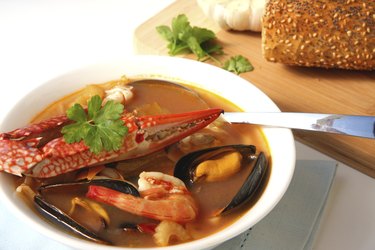
It doesn't require a great leap of imagination to believe that fisherman have been eating their unsold catch at dinner for as long as there have been fishermen. Frugally stretching that leftover fish by turning it into soup is an equally obvious step, and coastal regions the world over boast their own distinctive seafood soups. The differences between closely related dishes -- such as French bouillabaisse and Northern California's cioppino -- can sometimes be difficult to quantify.
Location, Location, Location
Video of the Day
Bouillabaisse hails from Provence, on the south coast of France, and is especially identified with the historic port city of Marseille. Cioppino is similarly identified with San Francisco, half a world away, but that's misleading. The dish originated with fishermen from Italy's Ligurian coast -- bordering Provence -- transplanted to California's reassuringly similar climate in the 19th century. They adapted their own traditions of "burrida" and "zuppa di pesce" to a new range of Pacific seafoods, creating a familiar but distinctive dish.
Video of the Day
A Question of Technique
Despite their close family resemblance, cooking technique forms one clear distinction between cioppino and bouillabaisse. Both begin the same way, by making a broth rich with seafood, tomatoes and aromatics, but there's an extra step in the construction of bouillabaisse. Once the broth is ready and the fish cooked, the fish is removed from the pot and reserved. A healthy portion of olive oil is added, and then the broth is boiled madly -- likely the root of the word "bouillabaisse" -- to emulsify the oil into the broth. This, along with the saffron used as flavoring, helps give the broth its characteristically golden appearance.
What's Fresh Today?
Modern bouillabaisse was refined by local chefs in the early 19th century, transforming a rustic peasant dish into a proud regional specialty. The canonical version must contain a handful of specific Mediterranean fish, including conger eel, John Dory and the fearsome-looking scorpion fish or "rascasse." As long as they're present, individual restaurateurs are free to pile the bowl high with lobsters, langoustines or other expensive and eye-catching seafood. Cioppino is less formal and truer to its blue-collar roots, relying on the time-honored rule of "use what's available." The exception to this rule is Dungeness crab, a must-have ingredient in any cioppino. As with bouillabaisse, deluxe versions rely on lobster, mussels and similar high-end ingredients for added visual appeal.
A Few Other Final Touches
Pungent, aromatic and unmistakeable, saffron is essential to any bouillabaisse. It's usually complemented by fennel and orange peel, two equally characteristic Mediterranean flavors. Cioppino, again, is less formal. It can and frequently does use those flavors, but none are especially canonical. Like bouillabaisse, its flavor begins with onions and garlic, but cioppino generally contains bell peppers as well. Wine is another distinctive. Cioppino usually includes wine -- traditionally red, though white is perfectly acceptable -- but it's a contentious ingredient in bouillabaisse. One last difference comes at the table. Bouillabaisse is accompanied by toasted croutons spread with rouille, a sort of spicy mayonnaise.